Construction City
—— A Collective Unconsciousness Construction and An Alleyway Narration in Hong Kong City
—— A Video Essay for David & Alleyway
If the city is compared to a giant beast that swallows and throws up material and spirit, the arteries flowing in its body are highways and roads. The headlights flash like neon meteors, and people’s greatest desires rush on. Then there are those pedestrian bridges, those small roads without traffic lights, like veins that cycle people’s desire to go home, branch out from arteries and spread all over the city. Finally, we can find capillary-like alleys between organic buildings.
Unlike highways, alleys are not deliberately constructed, and most alleys are forced to be sandwiched between organic functional areas. The functional area here presents a metaphor different from “vascular-transportation-public transportation”. The functional area assumes a role other than transportation and is established for a certain urban construction function, which is a pragmatic application. An unintentional alley is formed between the two functional areas. Such alleys are quite different from highways and roads that are intended to be built. Highways are planned and created through taxation and planning, and they also have a subjective function. It is built as an active act to assume the primary role of public transport.
We can see in this pattern the similarity to the theory of the group unconscious (Jung, 1980). Expressways and highways are understood as the subjective part of the urban narrative. There are not many main roads, but they can assume the main function, and above them is a bright and open group consciousness. Where am I going today? Which way am I going today? Every subjective thought of people in the city is directly reflected on the main road. The main road is bright and magnanimous, carrying the functions of the basic consciousness part. The alley forms a strong contrast with the main road. Compared with the bright main roads, the alleys are especially dark and damp, which is obvious in Hong Kong. The alley carries an impromptu, purposeless narrative.
So, I structured my video like in such a way. First, I chose the David statue (di Lodovico Buonarroti Simoni, 1504) and myself. The statue itself constructs a common nature shared by all human beings (Anderson, 2016). Then I connect David with me, constructing a relationship from the general to the specific.
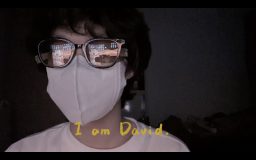
Then I covered David’s and my eyes with paintbrush and tape. The “eye” that heralds consciousness and subjective action disappears, and the unconscious takes the stage (Bruxelmane J et al., 2020).
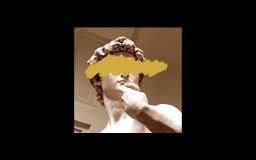
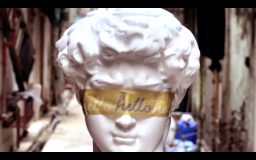
What follows are four classic narratives about what happens in the alleys of Hong Kong: drunkenness, fighting, chasing, and drug trafficking.
The alley is an important image in film and literature. The author favors the use of subconscious expressions. For example, an alcoholic must wander in the alleys, which is an unconscious wandering. For another example, detective novels favor the sense of tension and crisis reflected in the alley, which is exactly in line with what Freud advocated in the analysis of the unconscious, which is the accumulation of crises and anxieties that we cannot resolve.
Drunk, I chose “New Police Story” starring Jackie Chan.

For the fight, I chose Wong Kar Wai’s “As Tears Go By”.
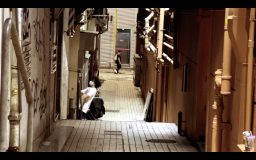
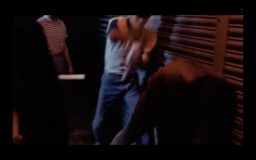
For the chase, I chose Wong Kar Wai’s “Chungking Express” and Oshii Mamoru’s “Ghost in the Shell”.

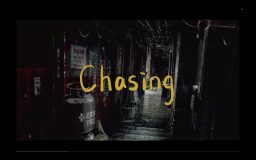
And for drug trafficking, the more unconscious drug trafficking in the alleys, rarely appears in Hong Kong films. Most of the drug trafficking in Hong Kong films are big syndicates, so I chose a more realistic narrative and selected some real photos (Anna Healy Fenton, 2015).
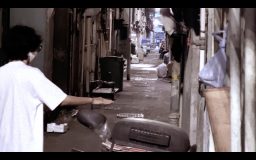

I chose the alleys of Mong Kok, Yau Ma Tei, Central and Kennedy Town as important backgrounds for the video. My technical means are iPhone13 Pro and stabilizer. I shoot solo. I chose slow-motion footage and time-lapse photography to imitate Wong Kar Wai’s Hong Kong narrative. I imitated pantomime, using body movements to describe a non-subjective, unconscious, dialogue. The length of the video has added a certain amount of mixed editing to compare the narrative method, and the original content after the editing has been removed is 2 and a half minutes long.
Hong Kong is a city where symbols are superficial, full of metaphors and chaos (Takeuchi Atsushi, as cited in David, 2011), full of strong symbols. When we do a mass psychoanalysis of the city, we find that it is a very restless city. The fast-walking pace of fishes-like office workers in Central clearly reflects the anxiety of the city. And in the dilapidated, cramped rooms just across the street from giant skyscrapers and neon screens are crowded families, and a strong sense of instability constitutes the city. And the most important image is every chaotic alley. The alleys are often full of kitchen waste, and the ground is full of puddles formed by air-conditioning water that has fallen from high places, and floating rainbow colors of oil stains. It was extremely dim and caught between the skyscrapers, and when I looked up, I could only see a gap-like sky. All kinds of tools are placed in the alley, and there is no obvious connection between the tools, and they are placed in a meaningless mess.
Therefore, we walk in the alleys, like walking in the capillaries of the city. Roaming, loss of purpose, restlessness, and dimness together constitute the basic image of the alley in the narrative of Hong Kong.
Credit:
Director: HOU Xiyuan
Photographer: HOU Xiyuan
Reference:
Anderson, S. (2016, August 17). David’s ankles: How imperfections could bring down the world’s most perfect statue. The New York Times. Retrieved May 12, 2022, from https://www.nytimes.com/2016/08/21/magazine/davids-ankles-how-imperfections-could-bring-down-the-worlds-most-perfect-statue.html
Bruxelmane J, Shin J, Olyff G, Bazan A. Eyes Wide Shut: Primary Process Opens Up. Front Psychol. 2020;11:145. Published 2020 Mar 3. doi:10.3389/fpsyg.2020.00145
Chan M. S. (Director). (2004). 新警察故事 [New Police Story] [Film]. Emperor Motion Pictures
David. (2011, March 8). Recreating Ghost in Hong Kong. Randomwire. https://randomwire.com/recreating-ghost-in-hong-kong/
https://www.scmp.com/magazines/post-magazine/article/1883520/why-hong-kong-nightlife-hubs-african-drug-dealers-do-what
di Lodovico Buonarroti Simoni, M. (1504). David [Carrara marble sculpture].Florence, Italy: Accademia di Belle Arti di Firenze.
Fenton, A. H. (2004, November 28). Why Lan Kwai Fong Has Seen a Surge in African Drug Dealers: SCMP Goes Undercover with the Hong Kong Police. South China Morning Post. https://www.scmp.com/magazines/post-magazine/article/1883520/why-hong-kong-nightlife-hubs-african-drug-dealers-do-what
Jung, C. G. 1., & Hull, R. F. C. 1. (1980). The archetypes and the collective unconscious. 2nd ed. Princeton, N.J.: Princeton University Press.
Oshii M. (Director). (1995). 攻殻機動隊 [Ghost in the Shell] [Film]. Production I.G
Wong K. W. (Director). (1988). 旺角卡門 [As Tears Go By] [Film]. In-Gear Film Production
Wong K. W. (Director). (1994). 重慶森林 [Chungking Express] [Film]. Jet Tone Productions
Fantastic video! You have really done a good job mimicking Wong Kar Wai’s style, and perhaps even in a smarter way than him. I really enjoyed it. Your concept of alleyways as urban spaces of unconsciousness is also wonderful, which gives me an unusual way of looking at our city as “conscious” and “unconscious”. I am wondering whether you mind elaborating more on how to apply Freudian analysis to this division methodology of urban space. I realized that 750 words are really limited, and I feel like it would be a great pity that such a stimulating insight is not fully explained.
Congrats on finishing such an aesthetic and professional film! You have identified an excellent metaphor, “blind (unconscious) David,” to describe the physical and psychological states of alleyways in Hong Kong, featuring the unconsciousness and subjectivity in the urban narrative. In the film, the anthropomorphism of architecture corresponds to the functional division in this city. The four self-acting scenes in parallel to four famous Hong Kong films are also innovative, while I think it would be better if you could elucidate why the four “classical narratives” can represent the features of the alley with textual reference to Freud (he is always too complicated to use).
I think you’ve done a wonderful job! Really appreciate your creativity and your courage.
It’s so innovative that you covered your eyes to represent unconsciousness and the alleyways in HongKong are “neglected” and purposeless. Your idea about film and literature uses alleyways for scenarios is incisive and the four plots you acted are just to the point and representative.
You brought the blinded David to the alleyways and acted the plots by yourself. Can’t imagine how hard it is to have such strong sense of belief when you were actually acting and filming in the alleyways.
Also like the bgm and filters you chose!
This is a captivating and aesthetically-pleasing video with amazing visual and audio designs. I love your style of imitating pantomime, and how in the opening you connect with David, used slow-motion and time-lapse to bring us away from the “conscious” main roads and enter the alleyways fantasy with you. The overlapping and reconciling with the movie clips make it as if we are in the world constructed by you and Wong Kar Wai collectively.
Your psychoanalysis of the city is thought-provoking. I have never come across with the theory of the group unconscious before, but it is an interesting analogy to draw and apply in urban space where in the alleyways, people’s subjective thoughts disappear, and your four classic narratives can take place. The definition of unconsciousness here seems a bit different from my usual understanding ,which is the accumulation of crises and anxieties that we cannot resolve. I think it would be great if more elaboration can be made on that. I also wonder if the instability and chaos of the city are connected with this central theory?
Really fascinating outlook for a post, with just nice amount of photos and inserts, really cool. The text is also well used, as a biology student, I can not agree more on the metaphor you have used, and the whole text gave well-explained purpose, effects and ideas. The video has a nice BGM hhh, and the alleys have strong representations, with strong sense to express the stance of essay, really cool. I think you can ask a friend to help hhh, it is a little bit strange with comparison of film insert. It also seems like two and a half minute is not enough for you, really nice movie !
I really like the music you used in the video and the run backward processing. The saturation enhancement provide a sense of slow pace and fantasy. The alleyway and slumdog in Hong Kong with the imagination of movie fragment both provide the sense of retro and urban. In short, the video is an enjoyable artwork.
I like the content of your video and the creativity with which you approach your topic. I particularly enjoy the part where you mention such concepts as collective unconsciousness and archetypes developed by Carl Jung, a popular psychoanalysist whose influence can be observed everywhere, especially in films and literature. I think this incorporation of psychoanalysis provides a solid theoretical foundation for your video essay, as a result of which your essay seems more cogent and convincing. Also, I think this unexpected merge between psychoanalysis and architecture offers a fresh perspective from which our daily experience of space can be radically re-evaluated, and let us discover the deep, subtle association between the human consciousness and the environment that surrounds it. This video essay is testimony to the power of architecture.